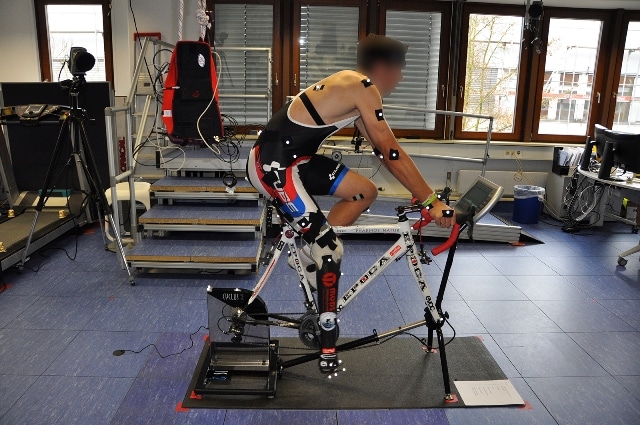Jul 5 2016
The 2016 Paralympic Games, which will be held in Rio de Janeiro in September, will see the participation of physically disabled cyclists. In order to guarantee maximum performance it is essential that the prosthetics used have the best design. However, fashioning prosthetics that can effectively manage the cyclists’ various movements has always been a challenge. A test prosthesis in a unique movement laboratory, has been helping to optimize the speed and accuracy of the artificial limbs.
 A cycloergometer and a test prosthesis help optimize prosthetics for athletes. (Credit: Fraunhofer IPA)
A cycloergometer and a test prosthesis help optimize prosthetics for athletes. (Credit: Fraunhofer IPA)
Riding a cycle with a prosthetic limb is a difficult feat. Although professional models have been designed for cyclists, designing prosthetics for athletes is not a simple task. Various versions of the same expensive prosthetic limb should be made in accordance with the athlete’s physical limitations, which differ from one athlete to another, in order to find the best suited artificial limb.
Prosthetics for Cyclists – Now Scientifically Optimized
A new mobile, biochemical measuring station has been set up by researchers from the Fraunhofer Institute for Manufacturing Engineering and Automation IPA, located in Stuttgart. The researchers have also designed an appropriate test prosthetic for the laboratory. The research is a collaboration project with the cycling department of National Paralympic Committee Germany (DBS) and the Medical Center at the University of Freiburg. Dr. Anja Hirschmüller from the Center has coordinated the project.
We can adjust the test prosthesis perfectly for each person. For the first time, we’re taking the athletes’ subjective perceptions to a scientific level.
Florian Blab, Scientist, Fraunhofer IPA
Until now, orthopedic technicians have been the ones making adjustments to the prosthetics, by hand.
The researchers have a dual goal of laying down parameters that will aid them in evaluating the moves of the athlete and check if a prosthetic suits them efficiently. These parameters will allow the researchers to adjust the prosthetics to fit the athlete’s body weight, physical characteristics and training level. The athlete is initially made to pedal at a cycloergometer, a stationary bike, with markers fixed on their various body parts.
As many as eight to twelve infrared cameras make a note of the markers on the athlete’s body to less than half a millimeter. Sensors are installed in the pedals to calculate the force applied, in three different spatial directions, by the athlete.
This data tells us both how much force the joint exerts and how much work the muscles are doing.
Florian Blab, Scientist, Fraunhofer IPA
In case the ergometer records a power of 300 watts, the scientists will be able to figure out if the power was fully generated by the athlete or if he/she is exerting more due to incorrect movements or due to energy lost in the artificial limb.
Simulation and Test Bikes Help Get it Right
The information gathered by the researchers is run through a software program, in order to make the right adjustments to the artificial limbs. The computer then provides all of the necessary adjustments while detecting the best three to four, which will be tested live with the athlete. Using the test prosthetic eliminates the need to change the prosthetics, by easily, effectively and immediately making the required adjustments to the setting. Aspects like position of the ball of the foot, point where the attachment of the pedal and sole has to be made and length of the artificial limb are some of the settings.
The data required will be gathered from the athletes’ training camp in Germany, before the Paralympics. The goal of the research is to enter into a long-term association with Germany’s national paracycling team that will extend even after the Paralympics in September 2016. The study also aims to ensure that the athletes in the years to come will have the necessary prosthetics.